Pay-per-click (PPC) marketing is the best way to drive more qualified leads to your website. Displaying your products or services on the first page of Google and Bing on relevant search queries has the potential to increase your conversions and revenue multifold. ROI (Return on Investment) is the key to manage your PPC campaigns. Targeting the right audience, at the right time, in the right place and device is crucial to achieving your digital marketing goals.
7 tips to optimize your PPC campaigns for maximum ROI-
-
Optimize the AdWords Account Structure
AdWords account must be structured, keeping relevancy in mind. The ad-groups, ads, and keywords should be highly relevant to each other if you want to lower your advertising costs and increase conversion rates. Segment campaigns by their niche and theme.
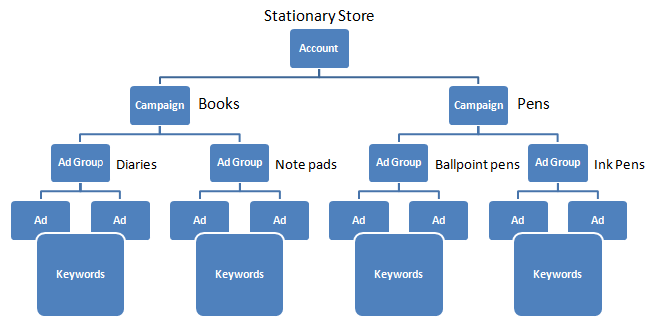
For example- If you sell stationery items, create separate campaigns for ‘Books’ and ‘Pens.’
Under the Diaries campaign, create Ad-groups such as diaries, note pads, etc. Each of these ad-groups should have at least two ads. It helps in ad rotation and AB testing. Similarly, create different Ad-groups for ‘Pens’ according to their attributes.
To simplify the planning and set up process for PPC AdWords account, use Google Keyword Planner or SEMrush PPC Keyword Tool to identify and organize keywords at the campaign and ad group level.
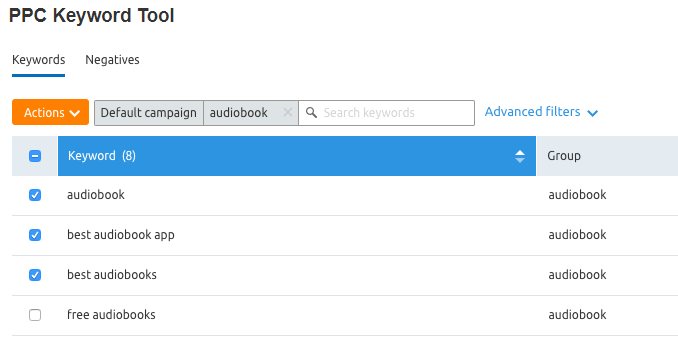
There is also an option to import your competitor’s organic and advertising keywords directly into your ad groups to stay one step ahead of your competitors. You can set negative keywords, remove duplicate keywords and easily export the optimized campaign plan to import directly into AdWords Editor.
-
Create Relevant Landing Pages
The success of a PPC campaign is judged by sales and not just by clicks. The landing page must be well designed to convert qualified leads into paying customers. Landing page relevancy is highly important for a good quality score of Ads. The Ad position or Ad rank depends on the quality of your computer and mobile landing page experience. The message displayed in your ad copy should closely align with the message on the landing page.
The keywords, CTA and offers on your landing page should be similar to your ad copy. It is not a good idea to direct the ads to your homepage without any thought. Even if the homepage is a landing page, it must be tailored to meet the perfect landing page’s requirements with all the information the customer needs to take the appropriate action.
By crafting well-thought landing pages, you reduce the effort required by customers to search for a product or relevant information on the website. Create separate landing pages for each product, with helpful descriptions and information, and a clear call-to-action button such as “shop now” or “free trial.” The ad copy should then use this information to generate customer curiosity, increasing click-through rate (CTR).
-
Bid on Competitor’s Keywords
Create a separate campaign to bid on competitor’s keywords and brand name. It is a legitimate technique to steal leads and acquire potential customers. You must research your competitor’s unique selling points and current offers. Try to beat the competitor by offering a better deal in your ad copy.
While creating Ads that target your competitor brand names and key phrases, be wary of using Dynamic Keyword Insertion in your ad copy. With Dynamic Keyword Insertion, your keyword is automatically inserted into your ad based upon the search query. It is illegal to use a competitor’s name in your ad copy. Sure, you can bid on competitor’s keywords, but adding their name is a big no-no and can get you in trouble with Google’s trademark policy or legal action from competitors. So, with Ad groups with competitor names as keywords, don’t use DKI (Dynamic Keyword Insertion).
SEMRush Advertising Research
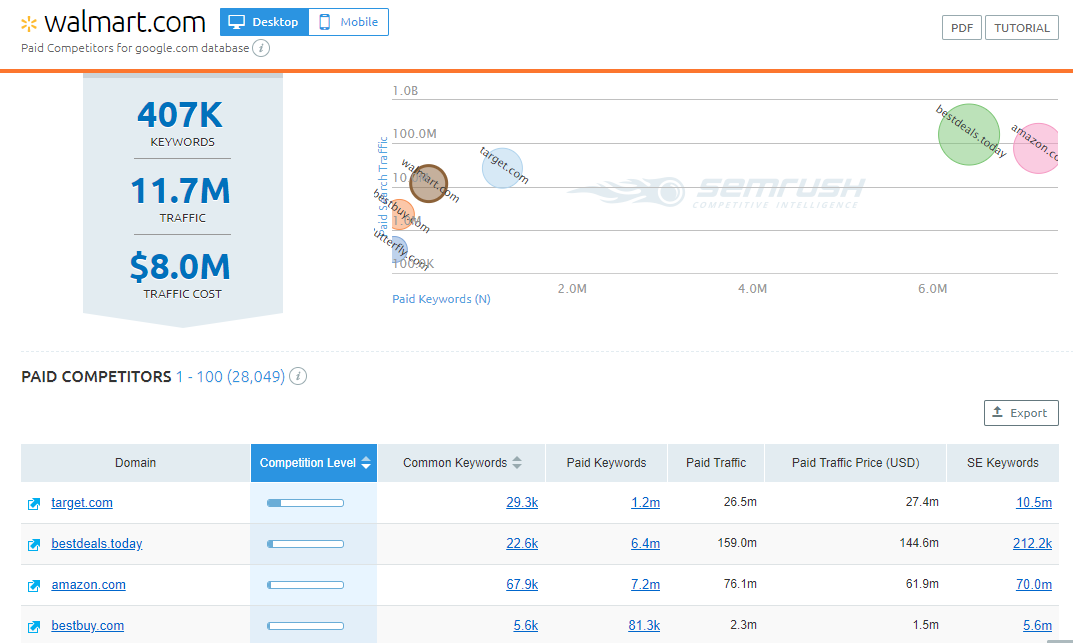
SEMrush Advertising Research allows you to have a birds-eye view of the competitor’s PPC marketing techniques. You can see competitor’s best keywords, ad copies, SERP, and landing page URLs on a single screen.

Use PPC Keyword Tool to organize keywords at the campaign and ad group level, set negative keywords, and easily imports the results into AdWords Editor!
-
Optimize Negative Keywords
This cannot be stressed enough. Optimization for negative keywords is of utmost importance to maintain the integrity of the AdWords account. It can save you money by not showing your ads on irrelevant search terms. For example, if you are a medical supply company selling new wheelchairs, ensure you receive qualified traffic by excluding search terms like “rent,” “second hand,” etc. Avoid clicks at places where the user intent doesn’t match with your business goals.
It is best practice to add negative keywords at the campaign level, but you can also add specific negative keywords to ad groups if required.
-
Use the Right Keyword Match Types
The keywords and the type of modifiers can be the game changers of the PPC campaign. Using the right keyword modifier not only reduces cost but also helps bring the most qualified leads to your website. There are four kinds of keyword modifiers.
Broad Match: This is meant to give the most impressions and reach the widest audience. It is the default match type. Broad match displays your ad whenever a user’s search query includes any word in your target keyword, in any order which includes its synonyms. For example, if you use broad matches on “fast bikes,” your ad might be displayed if a user types “luxury bikes,” “speed bikes,” or even “fast airplane.” Using broad match results in the highest number of irrelevant clicks and cost and must be carefully used.
Broad Match Modified: It is signified by a (+) sign in front of your keyword phrase. The broad match modifier will only display the ad if the keywords are in the order specified by you.
Phrase Match: The Keyword phrases are contained in quotation marks. The phrase match will only show your ad copy when the search query contains the exact keyword phrase specified by you. The order of the keyword phase might be changed.
Exact Match: The keywords are placed in brackets. It is similar to phrase match, with the difference that the target keywords should exactly match the user’s search query. Exact Match has the lowest impressions, but the leads are highly qualified. It is also the most cost-effective.
SEMrush Keyword Magic Tool
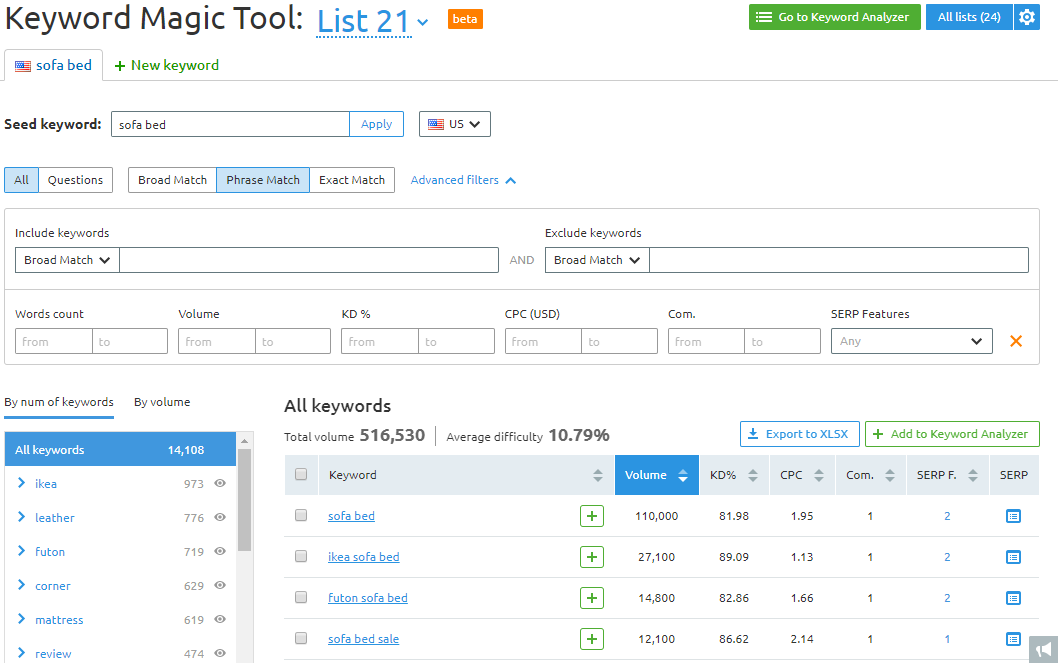
SEMRush Keyword Magic Tool helps you discover new keywords. You can organize the related keywords by match types and group them by topic and other relevant statistics. Keyword Magic Tool is integrated with other tools, which allows you to discover new keywords and launch an optimized AdWords campaign quickly.
-
Build Exquisite Ad Copies Using Expanded Text Ads
The ad copy should list the key information about the product or services offered on the landing page. It is best to check out the competitor ad copies and offers on display. Adjust your ad copy to match the competitor’s deal. It can be free shipping, special deals or promotions, or loyalty rewards. Your ad copy must stand out from the rest of the competition. Use strategic call-to-actions such as “free consultations” “Call Now for the best deal” to encourage customers to click on your ad.
Expanded Text Ads (ETAs) offer additional space to convey important information about your product or service. Make the maximum use of ETAs by strategically filling all information fields.
Expanded Text Ads Fields
Final URL: The Display URL populates automatically from the Final URL. The final URL can be a unique and highly relevant landing page.
Headline 1: The 30-character headline can be used to include the brand name and the unique selling point of products or services.
Headline 2: The 30-character headline should include vital information and a description of the product or service along with a captivating offer or CTA.
Path 1 and Path 2: The two optional 15-character path fields can be used to provide the context of your product or service. It can be used to include the most important target keywords of your landing page.
Description: The 80-character description field can be used to empathize with your customers’ needs and aim to provide solutions to their pain points. The description can end with a strong CTA or a statement or question to generate curiosity that would trigger the customer to know more about your products or services.
SEMrush Ad Builder-
To maximize the benefits of extended text ads, you can use SEMrush Ad Builder to build extended text ads based on your advertising campaigns. The build-in Ads research function makes it easy to check the latest competitors’ offers on ads and use them as templates.
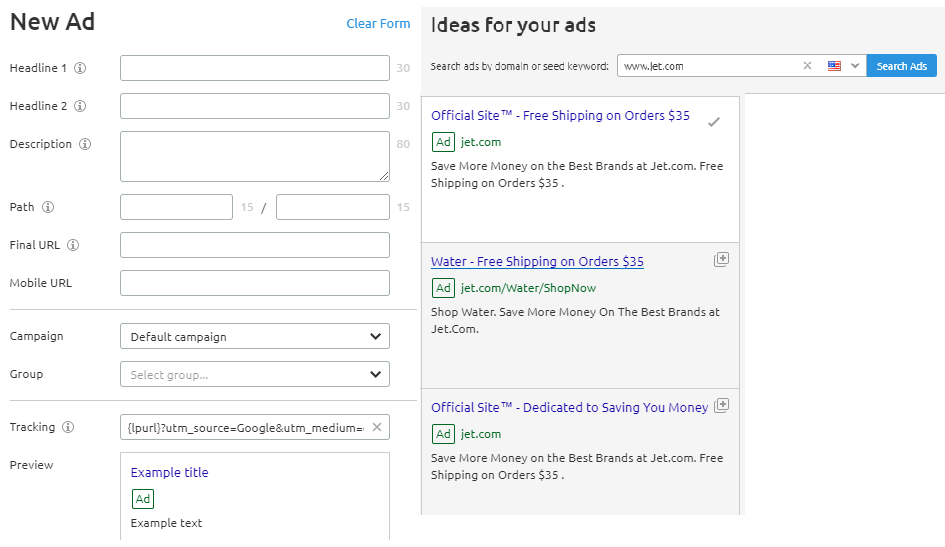
-
Edit/change Existing Low-Performance Ads
Doubts and hesitation prevail regarding editing or changing the old ads due to fear of losing historical data. One of the important factors in determining the Ad position or Ad rank is the quality of Ads or ‘Quality Score,’ which depends on Ad relevance, landing page experience, and expected CTR. The third component, “CTR,” is a minor pie in the component compared to the first two. Google looks at older CTR (ad’s historical clicks and impressions) to determine how well your ad matches somebody’s search and assigns Ad rank.
It is recommended to change existing Ads and create new effective and engaging Ads. If the CTR is below 1.0% for existing Ads, you can safely remove it and create a better Ad. The new better Ad would generate a higher Ad Rank and quality score rather than being pulled back due to the low CTR of the old Ad. Any Ad with low CTR is considered bad by Google. The CTR depends on your industry and product type, but it is safe to assume that any ad below 1% needs to be reviewed. It is better to pause the Ad and create a new one. The historical data would be available for view in the “removed ads” section. The best converting ads naturally have high CTR and should not be changed.
Every time you edit an ad, the new ad is created, and the statistics reset to begin a new ad history. If you wish to edit the ads in bulk without losing the historical data, use ad customizers. You can add parameters that go within braces { } to change its value dynamically. This will not create a new ad. Ad customizer will allow a single text ad to have multiple variations specialized for each potential customer.
SEMrush Ad History Tool
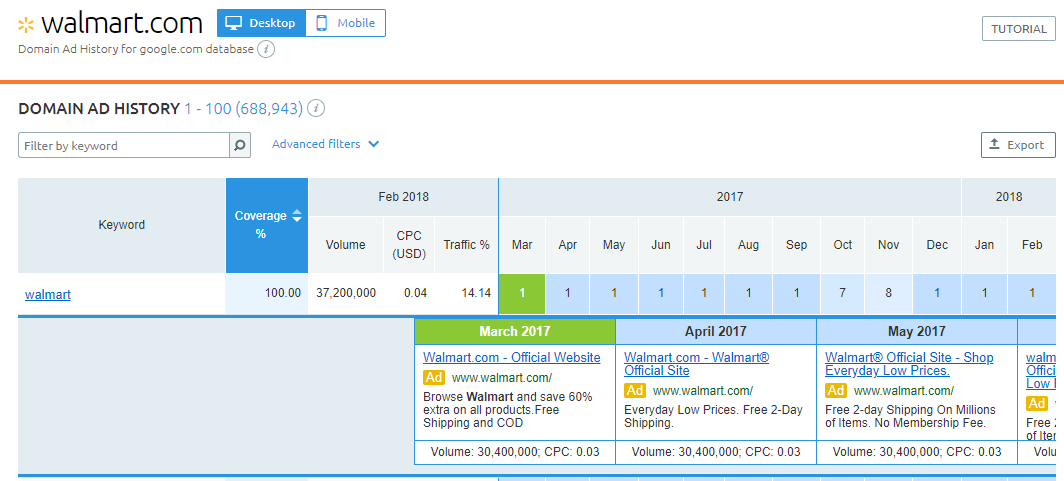
SEMrush Ad History Tool allows you to see the Ads that competitors used over the years, along with the Ad-positions. If the competitor runs a particular ad and offers continuously for many months, it is understood that it is performing well. You can tweak your ad copies and offer to match the best-performing competitor’s ads.
-
Use Every Relevant Ad Extension
Ad extensions can significantly improve your CTR by capturing the user’s attention. Currently, there are 10 different Ad extensions available in Google AdWords. Google recommends using all the extensions necessary for business goals. You should use at least four extensions in each campaign to boost the performance of ads. The Ad extensions currently available are Sitelinks extensions, Callout extensions, Structured snippet extensions, Call extensions, Message extensions, Location extensions, Affiliate location extensions, Price extensions, App extensions, and Review extensions.
-
Employ Geotargeting
Adjusting Geotargeting bids helps divert your marketing dollars to specific geographic locations that bring the most customers or revenue. It also offers the opportunity to optimize PPC campaigns based on weather, seasonality, special festivals, etc.
For example, if you sell snow coats, you should negatively bid in warmer areas like Florida and Texas and increase geotargeted bids for cities that have experienced snowfall to improve the chances of conversion and minimize the spend.
-
Target Customers Based on Day and Time
To optimize your AdWords account’s performance, target the potential customers during the time and days when they are most active. From the historical data or google analytics report, you can easily determine the time and days that result in most conversions with the least spending.
Most importantly, you can use the Ad Schedule feature of Google AdWords to stay one step ahead of competitors. You can either increase the bids during the day or days of the week when the search queries related to your business are most searched. Alternatively, you can decrease the bids during times or days when your expenditure is high, but conversions are low. Adjusting the bids according to time and days is the secret to achieve maximum ROI.
-
Optimize Mobile Campaigns
Mobile devices can’t be ignored when it comes to PPC Marketing. Advertising on mobile and tablets is more important now than ever before. It is vital to have separate campaigns optimized for mobile users to drive more qualified clicks.
Seeing the engagement and conversion trends by devices, you can easily determine the campaigns that can do well with the mobile-only components. The easiest way to go for mobile-only campaigns is to copy an existing campaign. Negative bid mobile for the original campaign and at the same time negative bid desktop for the newly created mobile-only campaign.
CPC for mobile ads is generally lower compared to desktop-only campaigns. With mobile-optimized campaigns, you can also take advantage of click-to-call extensions.
-
Make Use of Google Recommendations on Opportunity Page
AdWords Opportunity Page can definitely help you improve your campaigns’ performance and make informed decisions about future growth. It makes it easy to understand the overall performance and efficiency of your advertising campaigns. The recommendations page works best if you have an established account history. It suggests the changes and estimates the performance based on historical data.
A properly optimized PPC campaign can take your business to a new level. Ensure to take all available opportunities to optimize the user experience and drive conversions. The above tips and techniques will help you optimize the cost-to-sale ratio or ROI of your PPC campaign. Make every dollar spent on advertising count.

Hunaid Germanwala is a digital marketer and content creator at Health Products For You since 2014. He has an MS from Ulm University in Germany. His mind is always buzzing with creative ideas and is eager to explore new perspectives. His motto in life is “Better to Light the Candle than to Curse the Darkness.”
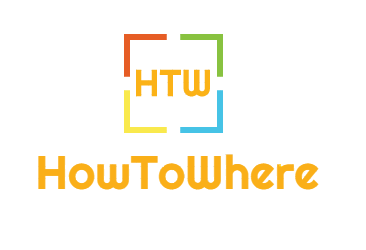
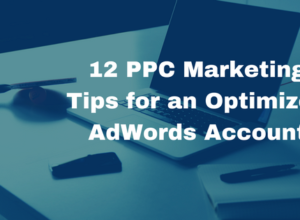








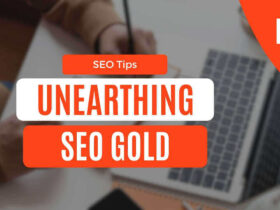
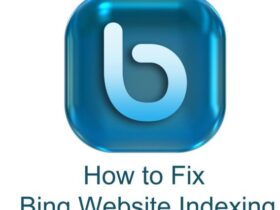


Leave a Reply